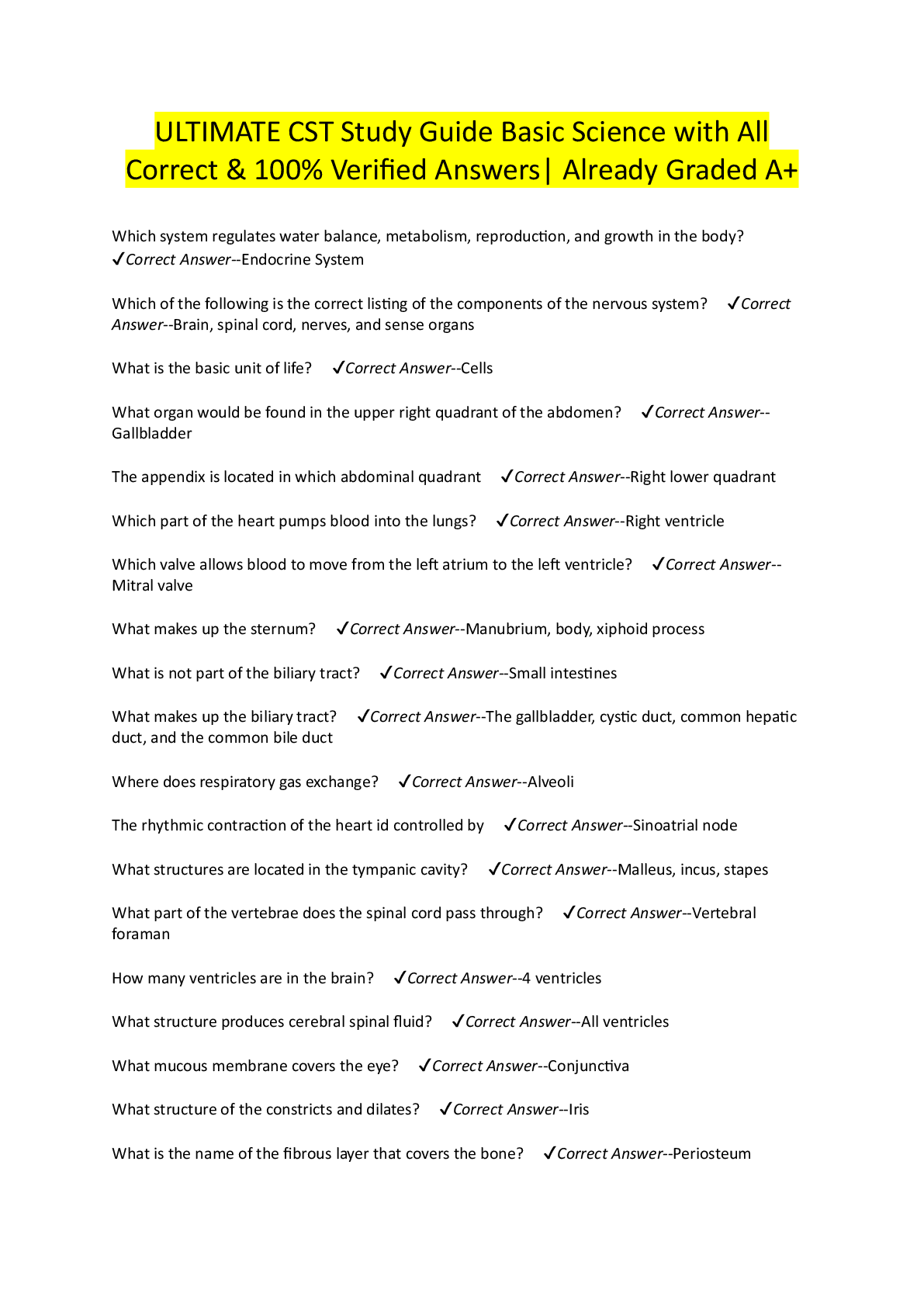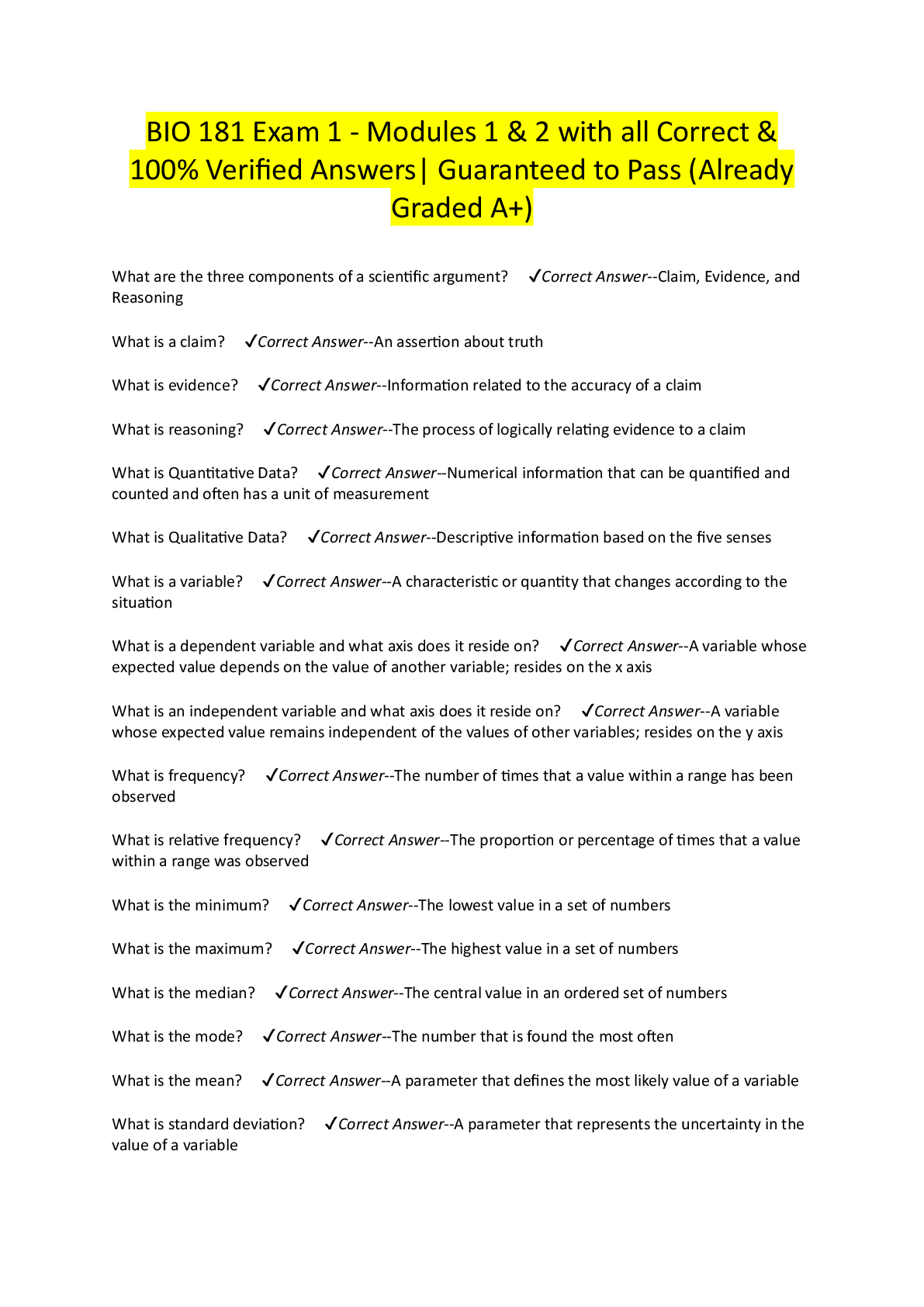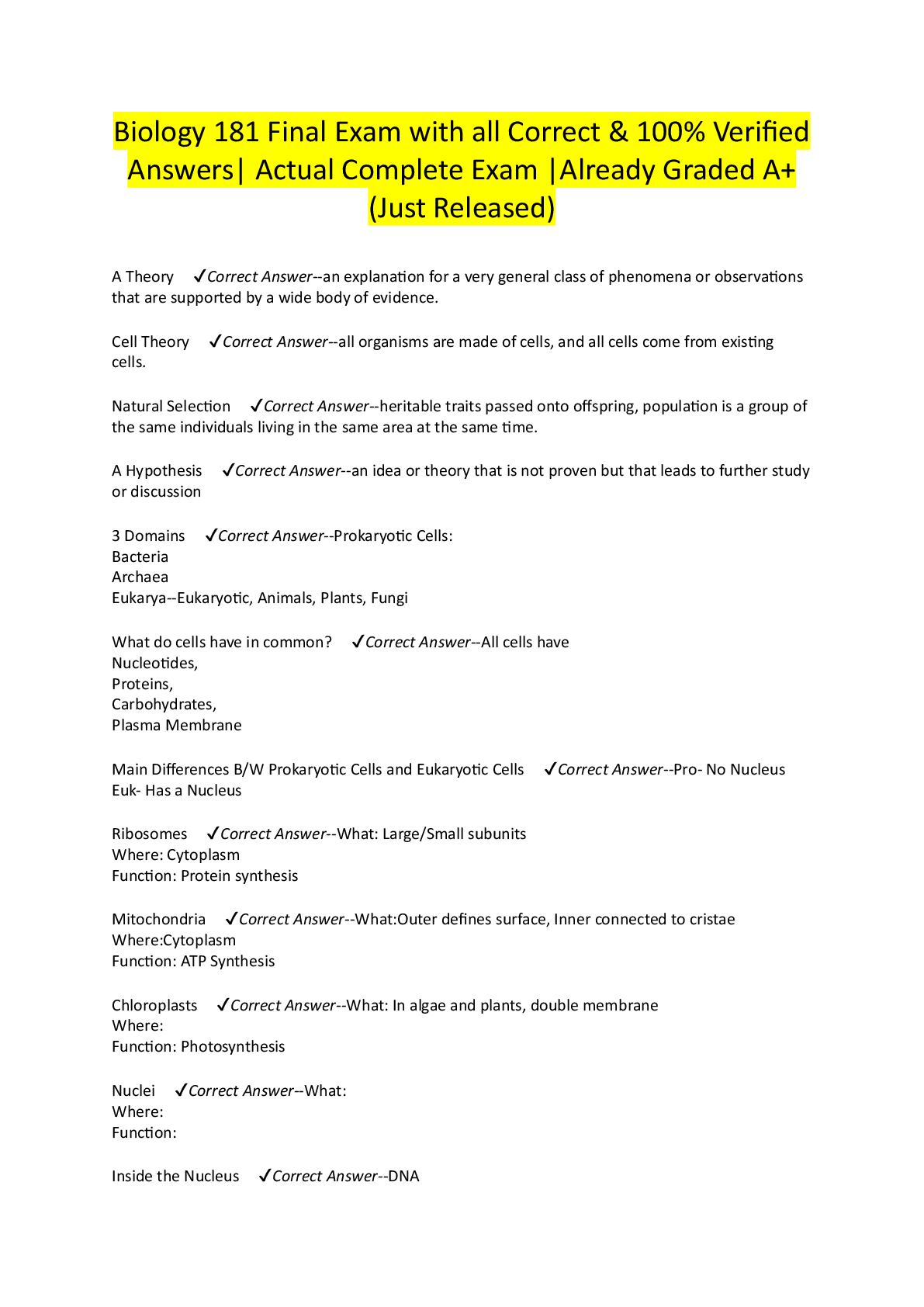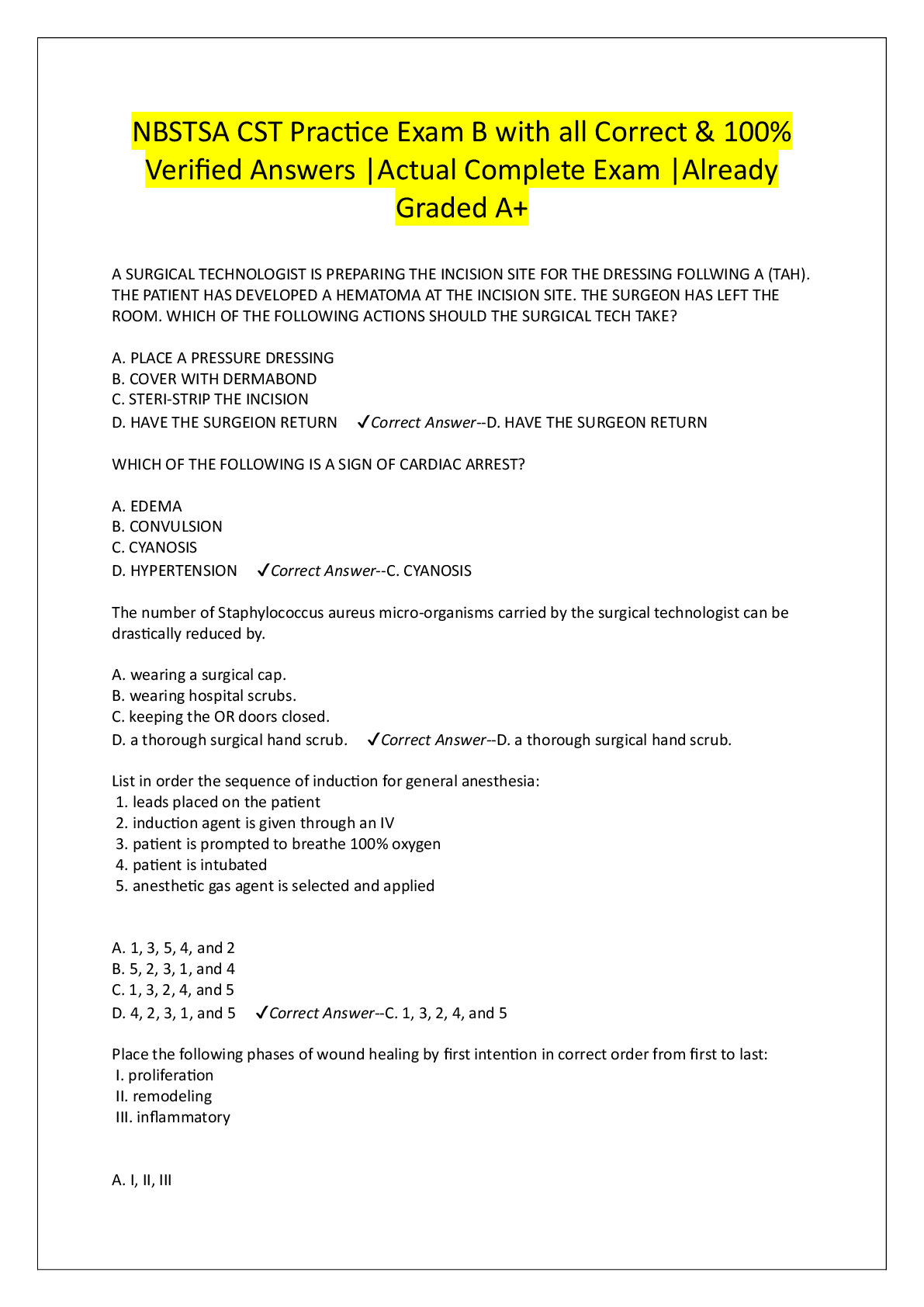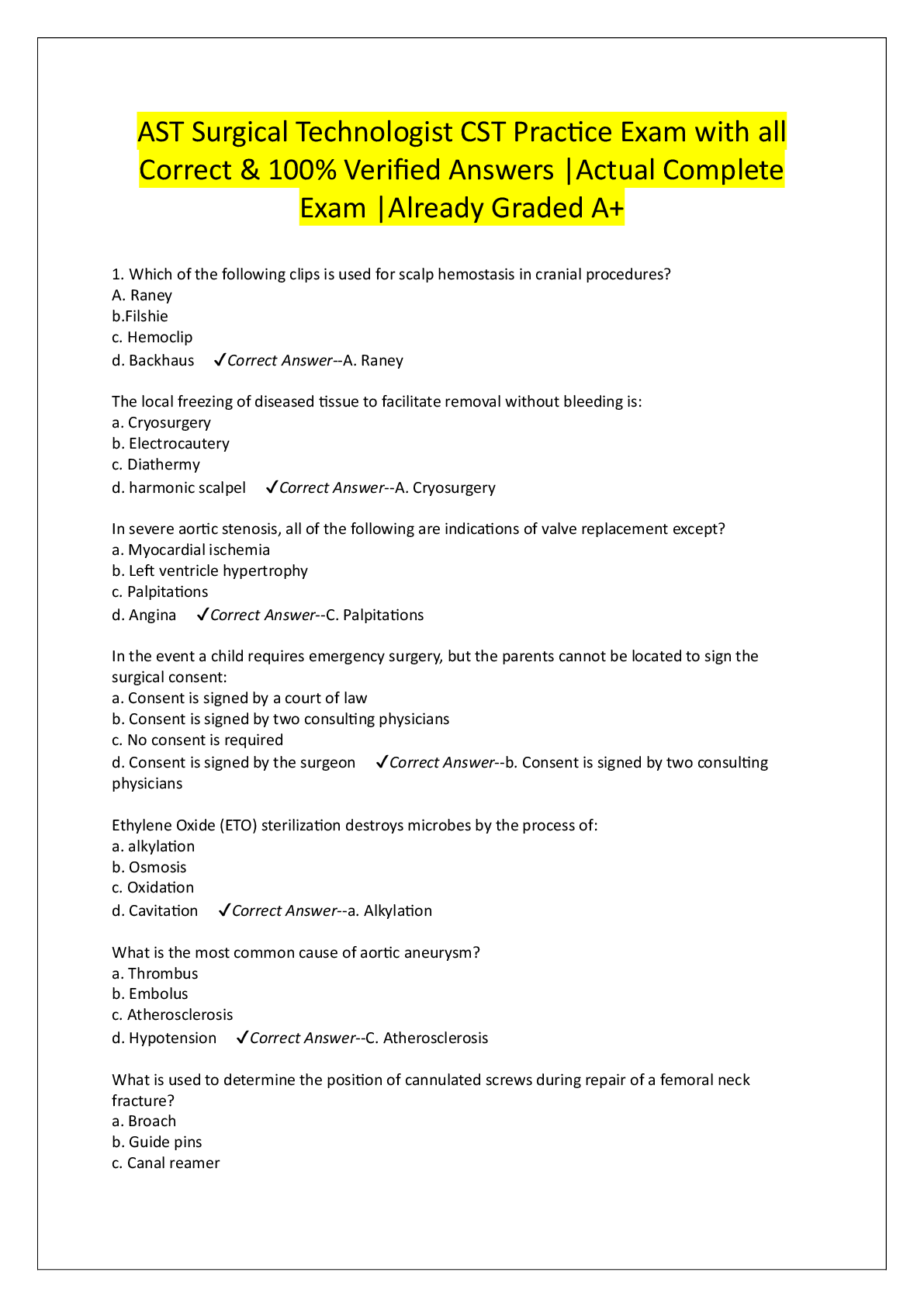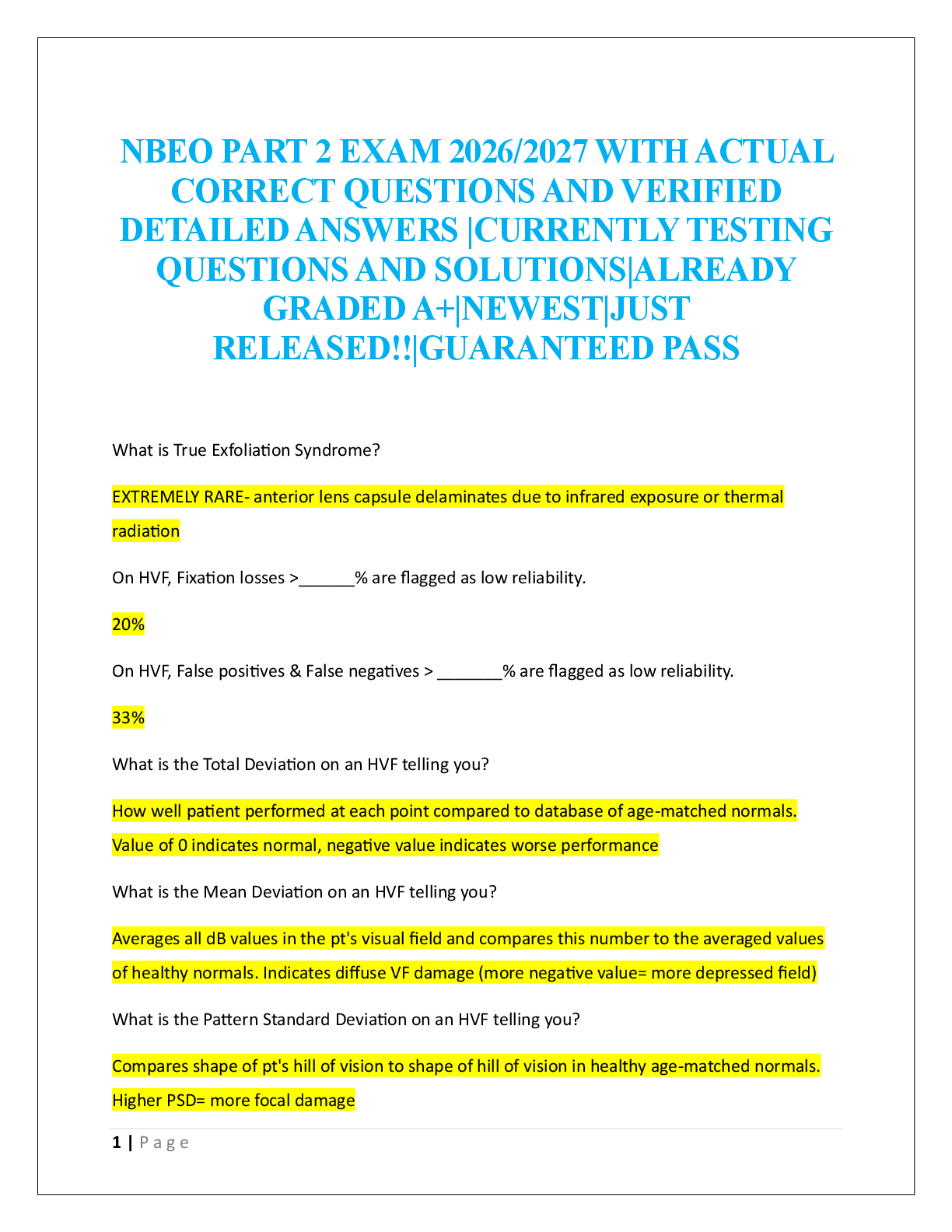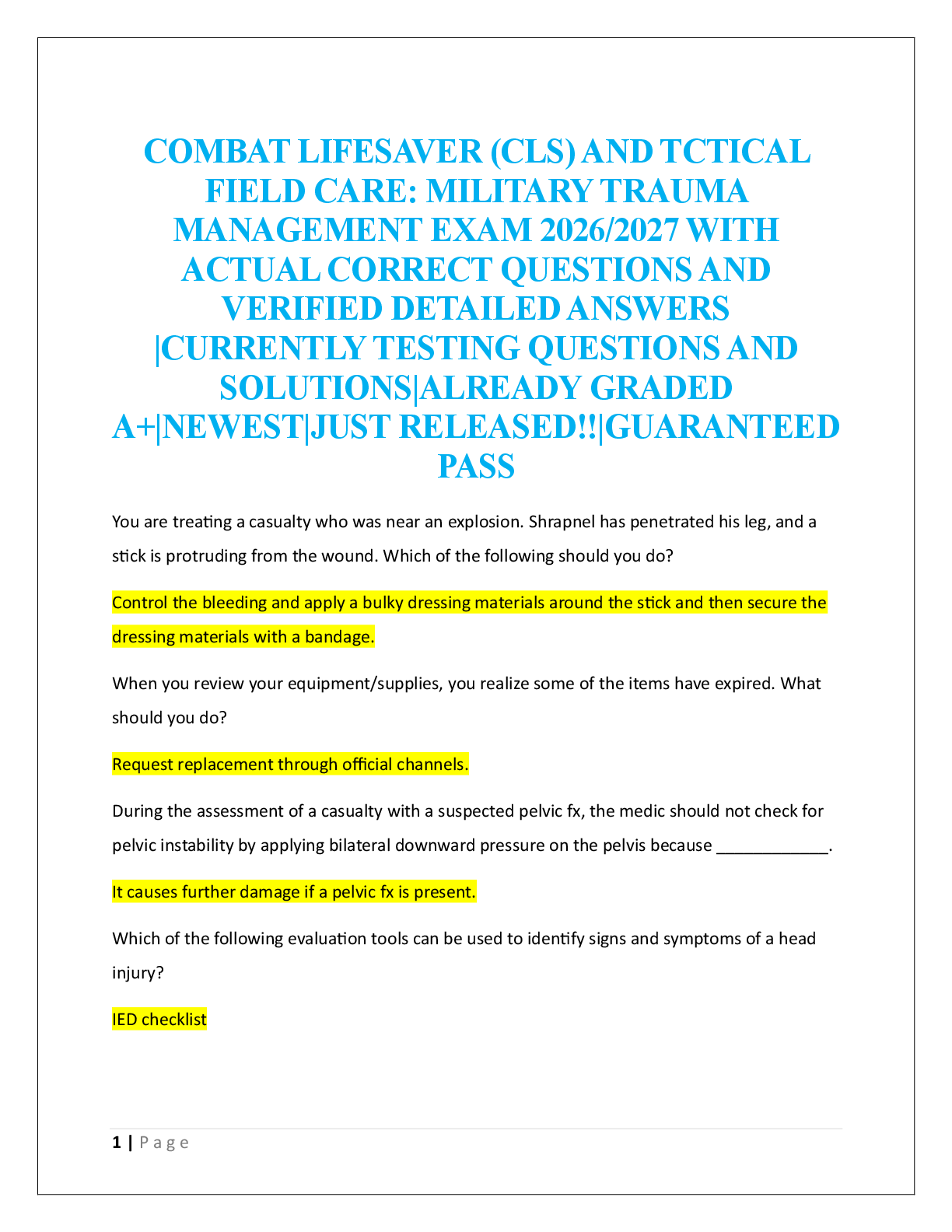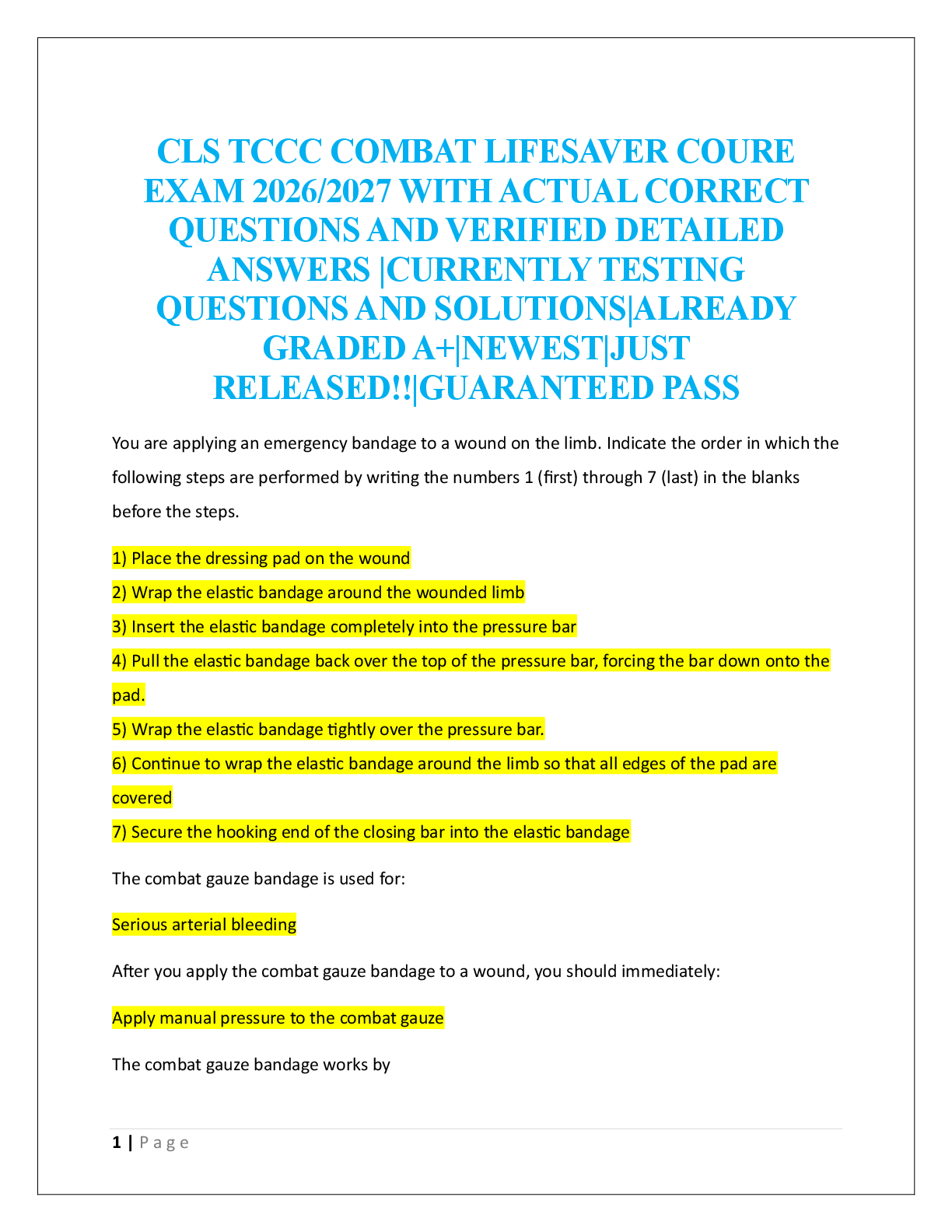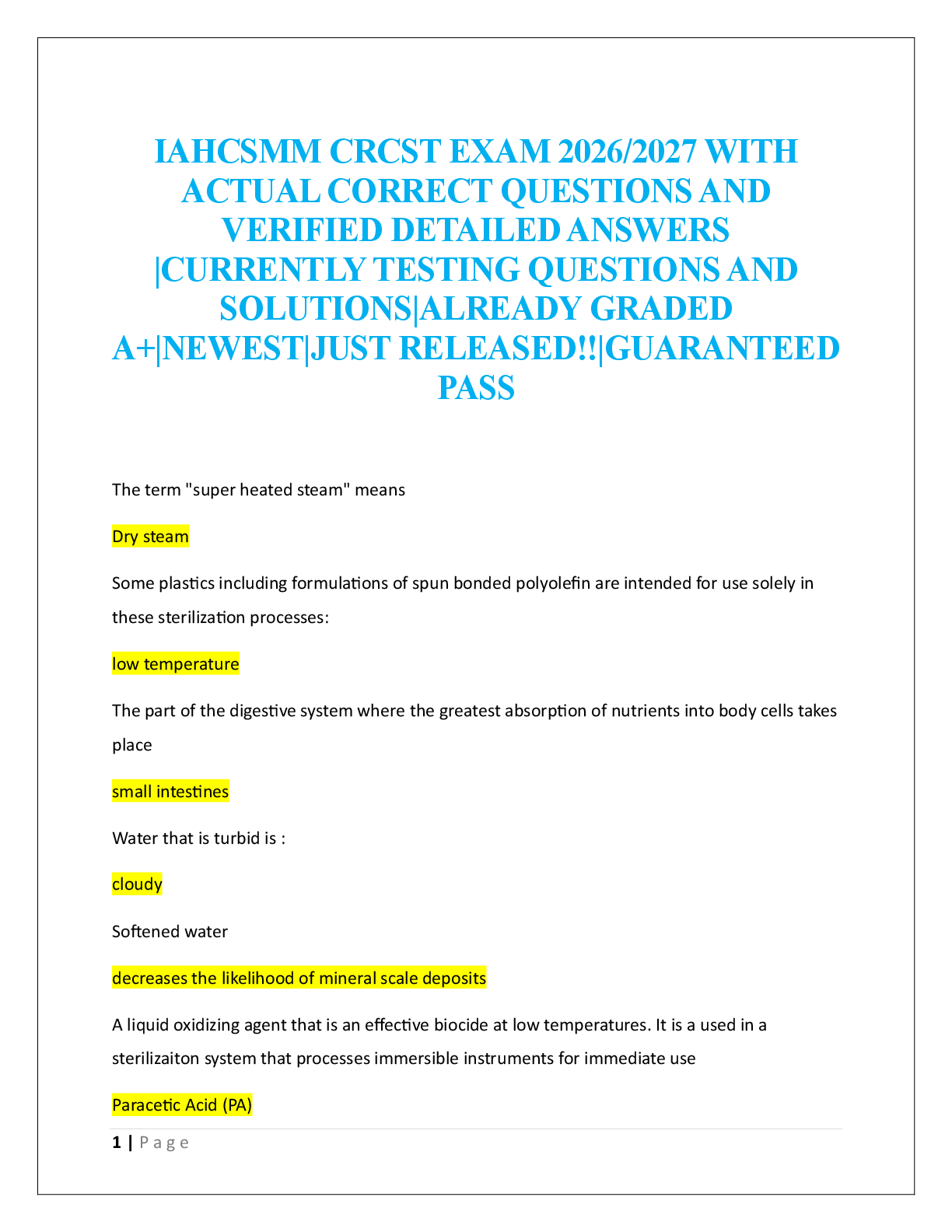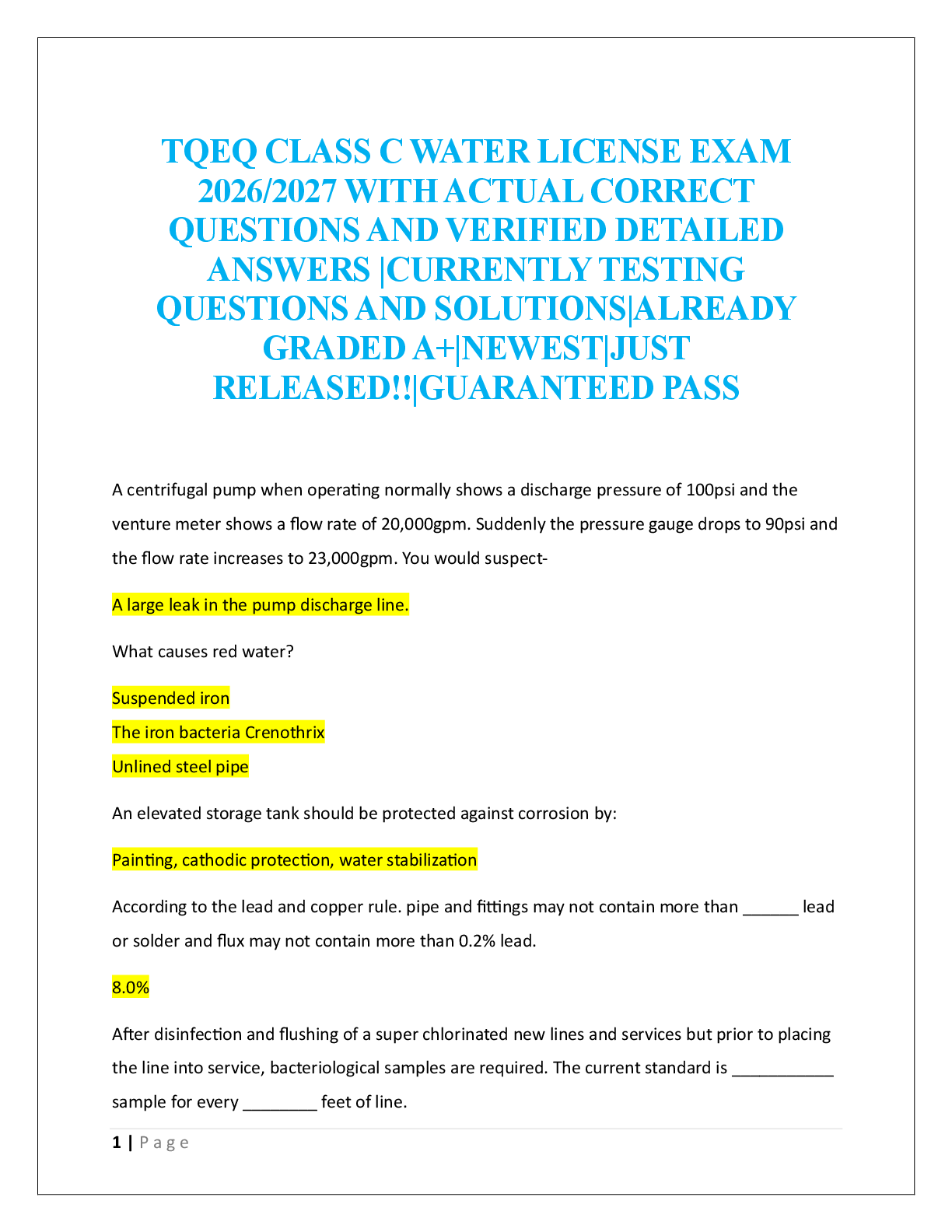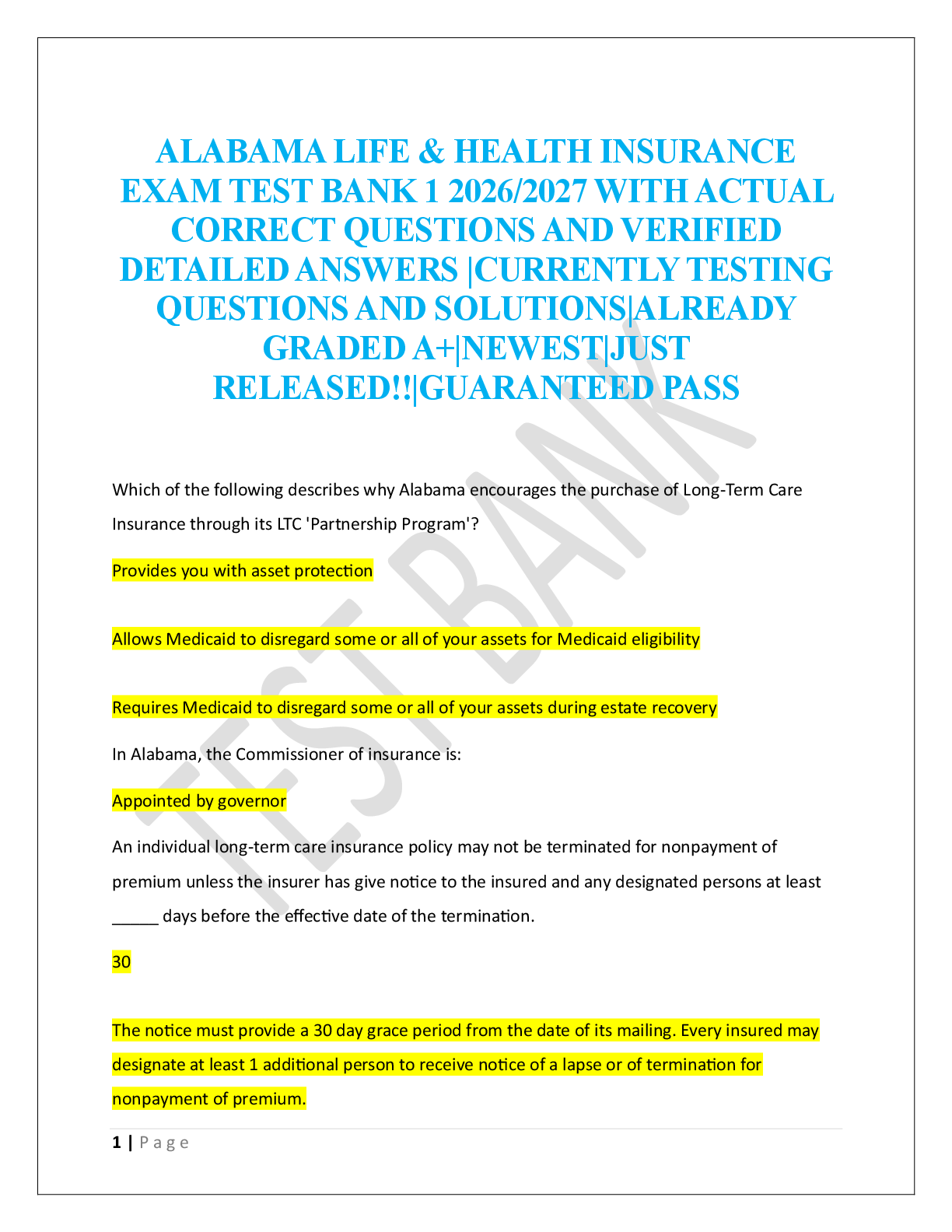*NURSING > EXAM > NR327 - Quiz 4 - Postpartum NCLEX-Style Questions (For Quiz 4) - July 2019 Source Of Questions For (All)
NR327 - Quiz 4 - Postpartum NCLEX-Style Questions (For Quiz 4) - July 2019 Source Of Questions For This Quiz: Saunders Comprehensive Review - NCLEX-RN Exam Topics For This Quiz: Postpartum Physiologic Adaptations Postpartum Psychosocial Adaptations Postpartum Complications Assessment of the Normal Newborn Care of the Normal Newborn
Document Content and Description Below
NR327 - Quiz 4 - Postpartum NCLEX-Style Questions (For Quiz 4) - July 2019 Source Of Questions For This Quiz: Saunders Comprehensive Review - NCLEX-RN Exam Topics For This Quiz: Postpartum P ... hysiologic Adaptations Postpartum Psychosocial Adaptations Postpartum Complications Assessment of the Normal Newborn Care of the Normal Newborn Postpartum Physiological/Psychosocial Adaptations & Postpartum Complications NCLEX-Style Questions (For Quiz 4): 1. A nurse is performing a fundal assessment for a client who is 2 days postpartum and observes the perineal pad for lochia. she notes the pad to be saturated approximately 12 cm with lochia that is bright red and contains small clots. Which of the following findings should the nurse document? A. Moderate lochia rubra B. Excessive blood loss C. Light lochia rubra D. Scant lochia serosa 2. During ambulation to the bathroom, a postpartum client experiences a gush of dark red blood that soon stops. on assessment, a nurse finds the uterus to be firm, midline, and at the level of the umbilicus. Which of the following findings should the nurse interpret this data as being? a. Evidence of a possible vaginal hematoma B. an indication of a cervical or perineal laceration c. a normal postural discharge of lochia d. abnormally excessive lochia rubra flow 3. A nurse is completing postpartum discharge teaching to a client who had no immunity to varicella and was given varicella vaccine. Which of the following statements by the client indicates understanding of the teaching? A. "i will need to use contraception for 3 months before considering pregnancy." B. "i need a second vaccination at my postpartum visit." C. "i was given the vaccine because my baby is o-positive." D. "i will be tested in 3 months to see if i have developed immunity." 4. a nurse is assessing a postpartum client for fundal height, location, and consistency. the fundus is noted to be displaced laterally to the right, and there is uterine atony. the nurse should identify which of the following conditions as the cause of the uterine atony? a. Poor involution B. urinary retention c. hemorrhage d. infection 5. a nurse is caring for a client who is 1 hr postpartum following a vaginal birth and experiencing uncontrollable shaking. the nurse should understand that the shaking is due to which of the following factors? (select all that apply.) a. change in body fluids B. metabolic effort of labor c. diaphoresis d. decrease in body temperature E. decrease in prolactin levels 6. a nurse concludes that the father of an infant is not showing positive signs of parent‑infant bonding. He appears very anxious and nervous when the infant's mother asks him to bring her the infant. Which of the following actions should the nurse use to promote father‑infant bonding? a. Hand the father the infant, and suggest that he change the diaper. B. ask the father why he is so anxious and nervous. C. Tell the father that he will grow accustomed to the infant. d. Provide education about infant care when the father is present. 7. a client in the early postpartum period is very excited and talkative. She is repeatedly telling the nurse every detail of her labor and birth. Because the client will not stop talking, the nurse is having difficulty completing the postpartum assessments. Which of the following action should the nurse take? a. Come back later when the client is more cooperative. B. Give the client time to express her feelings. C. Tell the client she needs to be quiet so the assessment can be completed. d. redirect the client's focus so that she will become quiet. 8. A nurse is caring for a client who is 1 day postpartum. The nurse is assessing for maternal adaptation and mother‑infant bonding. Which of the following behaviors by the client indicates a need for the nurse to intervene? (Select all that apply.) a. demonstrates apathy when the infant cries B. Touches the infant and maintains close physical proximity C. Views the infant's behavior as uncooperative during diaper changing d. identifies and relates infant's characteristics to those of family members e. interprets the infant's behavior as meaningful and a way of expressing needs 9. A nurse is caring for a client who is 2 days postpartum. The client states, "My 4‑year old son was toilet trained and now he is frequently wetting himself." Which of the following statements should the nurse provide to the client? a. "your son was probably not ready for toilet training and should wear training pants." B. "your son is showing an adverse sibling response." C. "your son may need counseling." d. "you should try sending your son to preschool to resolve the behavior." 10. A nurse in the delivery room is planning to promote maternal‑infant bonding for a client who just delivered. Which of the following is the priority action by the nurse? a. encourage the parents to touch and explore the neonate's features. B. limit noise and interruption in the delivery room. C. Place the neonate at the client's breast. d. Position the neonate skin‑to‑skin on the client's chest. 11. a nurse is conducting a home visit for a client who is 1 week postpartum and breastfeeding. the client reports breast engorgement. Which of the following recommendations should the nurse make? a. "apply cold compresses between feedings." B. "take a warm shower right after feedings." C. "apply breast milk to the nipples and allow them to air dry." d. "use the various infant positions for feedings." 12. a nurse is providing discharge instructions for a client. at 4 weeks postpartum, the client should contact her provider for which of the following client findings? a. scant, nonodorous white vaginal discharge B. uterine cramping during breastfeeding C. sore nipple with cracks and fissures d. decreased response with sexual activity 13. a nurse is providing discharge teaching for a nonlactating client. Which of the following instructions should the nurse include in the teaching? a. "Wear a supportive bra continuously for the first 72 hours." B. "Pump your breast every 4 hours to relieve discomfort." C. "use breast shells throughout the day to decrease milk supply." d. "apply warm compresses until milk suppression occurs." 14. a nurse is providing discharge instructions to a postpartum client following a cesarean birth. the client reports leaking urine every time she sneezes or coughs. Which of the following interventions should the nurse suggest? a. sit‑ups B. Pelvic tilt exercises C. Kegel exercises d. abdominal crunches 15. a nurse is providing care to four clients on the postpartum unit. Which of the following clients is at greatest risk for developing a postpartum infection? a. a client who has an episiotomy that is erythematous and has extended into a third‑degree laceration B. a client who does not wash her hands between perineal care and breastfeeding C. a client who is not breastfeeding and is using measures to suppress lactation d. a client who has a cesarean incision that is well‑approximated with no drainage 16. a nurse is caring for a client who is postpartum. the nurse should identify which of the following findings as an early indicator of hypovolemia caused by hemorrhage? a. increasing pulse and decreasing blood pressure B. Dizziness and increasing respiratory rate C. Cool, clammy skin, and pale mucous membranes D. altered mental status and level of consciousness 17. a nurse educator on the postpartum unit is reviewing risk factors for postpartum hemorrhage with a group of nurses. Which of the following factors should the nurse include in the teaching? (select all that apply.) a. Precipitous delivery B. obesity C. inversion of the uterus D. oligohydramnios e. retained placental fragments 18. a nurse on the postpartum unit is performing a physical assessment of a client who is being admitted with a suspected deep‑vein thrombosis (DVt). Which of the following clinical findings should the nurse expect? (select all that apply.) a. Calf tenderness to palpation B. mottling of the affected extremity C. elevated temperature D. area of warmth e. report of nausea A, C, D "A CORRECT A client report of calf tenderness to palpation is an expected finding in a client who has a DVt. B. mottling of the affected extremity is not an expected finding in a client who has a DVt. C. CORRECT: elevated temperature is an expected finding in a client who has a DVt. D. CORRECT: an area of warmth over the thrombus is an expected finding in a client who has a DVt. e. a report of nausea is not an expected finding in a client who has a DVt." 19. a nurse on the postpartum unit is planning care for a client who has thrombophlebitis. Which of the following nursing interventions should the nurse include in the plan of care? a. apply cold compresses to the affected extremity. B. massage the affected extremity. C. allow the client to ambulate. D. measure leg circumferences. 20. a nurse is caring for a client who has disseminated intravascular coagulation (DiC). Which of the following antepartum complications should the nurse understand is a risk factor for this condition? a. Preeclampsia B. thrombophlebitis C. Placenta previa D. Hyperemesis gravidarum 21. a nurse on the postpartum unit is caring for four clients. Which of the following clients should the nurse recognize as the greatest risk for development of a postpartum infection? a. a client who experienced a precipitous labor less than 3 hr in duration B. a client who had premature rupture of membranes and prolonged labor c. a client who delivered a large for gestational age infant D. a client who had a boggy uterus that was not well‑contracted 22. a nurse is teaching a client who is breastfeeding and has mastitis. Which of the following responses should the nurse make? a. "Limit the amount of time the infant nurses on each breast." B. "nurse the infant only on the unaffected breast until resolved." c. "completely empty each breast at each feeding or use a pump." D. "Wear a tight‑fitting bra until lactation has ceased." 23. a nurse is reviewing discharge teaching with a client who has a urinary tract infection. Which of the following statements by the client indicates understanding of the teaching? (select all that apply.) a. "I will perform peri care and apply a perineal pad in a back‑to‑front direction." B. "I will drink cranberry and prune juices to make my urine more acidic." c. "I will drink large amounts of fluids to flush the bacteria from my urinary tract." D. "I will go back to breastfeeding after I have finished taking the antibiotic." e. "I will take tylenol for any discomfort." 24. a nurse is caring for a client who has mastitis. Which of the following is the typical causative agent of mastitis? a. Staphylococcus aureus B. Chlamydia trachomatis c. Klebsiella pneumonia D. Clostridium perfringens 25. a nurse is discussing risks factors for urinary tract infections with a newly licensed nurse. Which of the following conditions should the nurse include in the teaching? (select all that apply). a. epidural anesthesia B. urinary bladder catheterization c. frequent pelvic examinations 26. a nurse is assessing a postpartum client who is exhibiting tearfulness, insomnia, lack of appetite, and a feeling of letdown. Which of the following conditions are associated with these clinical findings? a. Postpartum fatigue B. Postpartum psychosis C. Letting‑go phase D. Postpartum blues 27. a nurse is caring for a postpartum client who delivered her third infant 2 days ago. the nurse recognizes that which of the following findings are suggestive of postpartum depression? (select all that apply.) a. Fatigue B. insomnia C. euphoria D. Flat affect e. Delusions 28. a nurse is assessing a client who has postpartum depression. the nurse should expect which of the following findings? (select all that apply.) a. Paranoia that her infant will be harmed B. Concerns about lack of income to pay bills C. anxiety about assuming a new role as a mother D. rapid decline in estrogen and progesterone e. Feeling of inadequacy with the new role as a mother 29. a nurse is caring for a client who has postpartum psychosis. Which of the following actions is the nurse's priority? a. reinforce the need to take antipsychotics as prescribed. B. ask the client if she has thoughts of harming herself or her infant. C. monitor the infant for indications of failure to thrive. D. review the client's medical record for a history of bipolar disorder. [Show More]
Last updated: 3 years ago
Preview 1 out of 12 pages

Buy this document to get the full access instantly
Instant Download Access after purchase
Buy NowInstant download
We Accept:

Reviews( 0 )
$6.00
Can't find what you want? Try our AI powered Search
Document information
Connected school, study & course
About the document
Uploaded On
Dec 15, 2020
Number of pages
12
Written in
All
Additional information
This document has been written for:
Uploaded
Dec 15, 2020
Downloads
0
Views
100

.png)






.png)




